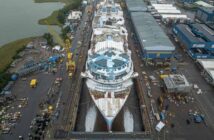The proportion of cruise ships worldwide based in the Caribbean has grown to 60pc and is set to grow further. And at the heart of this growth is another expansion, mirroring the growth in cruise ships, private islands and resorts owned by the cruise lines where they control the onshore spend of their customers.
As the sun-kissed waters of the Caribbean continue to draw holidaymakers from across the globe, major cruise lines are pouring millions of euros into transforming remote islands and beachfronts into exclusive resorts.
This trend, which began in the late 1970s, has accelerated dramatically in recent years, with operators like Royal Caribbean, Carnival, and Norwegian leading the charge. These private destinations not only offer passengers a seamless extension of their onboard experience but also allow cruise firms to maximise profits by capturing every euro spent on excursions, dining, and luxury add-ons. With the industry rebounding strongly post-pandemic, investments topping €1 billion across the sector, these enclaves are becoming must-stop ports of call, blending adventure, relaxation, and branded exclusivity.
The growth of these private islands and resorts has been nothing short of explosive. What started as simple leased beaches for barbecues and snorkelling has evolved into full-fledged theme park-style havens, complete with waterparks, zip lines, and overwater villas. Analysts estimate that by 2027, up to 90% of Caribbean cruises could include a visit to one of these operator-owned spots, driven by fuel savings from nearby locations and the allure of controlled, crowd-free environments.
“These aren’t just stops; they’re the heart of the itinerary now,” Patrick Scholes of Truist Securities. shares “Passengers love the exclusivity, and for cruise lines, it’s a goldmine—returns in the high teens on investments, often recouped in three to four years.”
Here’s a rundown of the key resorts and islands:
- Great Stirrup Cay (Bahamas): Owned and developed by Norwegian Cruise Line (NCL), this 250-acre island marks the birth of the private island era. Acquired in 1977 from Belcher Oil Company for an undisclosed sum (estimated at under €5 million in today’s terms), it was the first such venture by a major operator. Initially a basic beach spot for tenders from Florida ports, it has seen steady upgrades: a major €100 million expansion in 2017 added dining and walkways, followed by the luxurious Silver Cove retreat in 2019, featuring 38 private villas, a spa, and an infinity pool. Today, it’s a laid-back paradise with an Aqua Park for kids, snorkelling reefs, and beachfront cabanas—perfect for NCL, Oceania, and Regent passengers seeking a mix of adventure and serenity.
- Castaway Cay (Bahamas): Disney Cruise Line’s flagship private island, a 1,000-acre gem in the Abaco chain, was purchased in 1997 for around €15 million and developed into a family wonderland by 1998. Known for its Disney magic, the island includes character meet-and-greets (Mickey in island attire), a snorkel trail with “sunken treasures” like a submarine prop, and segregated beaches: Family Beach for all ages and the adults-only Serenity Bay. Recent enhancements include parasailing and kayaking through a blue lagoon. Exclusively for Disney ships, it’s a tender port that’s ultra-organised, with a post office for special Castaway stamps—ideal for multigenerational holidays.
- Half Moon Cay (Bahamas): Owned by Holland America Line (a Carnival Corporation brand) since its €5.5 million purchase of Little San Salvador Island in 1997, this 2,400-acre haven opened to passengers in 1998. Renamed Half Moon Cay, it boasts a stunning crescent-shaped beach voted “best private island” by Porthole Cruise Magazine for two decades. Developments include a kids’ waterpark, stingray swims, horseback rides along the shore, and luxury cabanas with butler service. Shared with Carnival Cruise Line ships, it’s a tender destination emphasising nature trails in a bird sanctuary and complimentary beach barbecues, blending relaxation with wildlife encounters.
- Princess Cays (Bahamas): Leased and developed by Princess Cruises (another Carnival brand) since 1992 on 40 acres at the southern tip of Eleuthera, this resort spans over 1.5 miles of white-sand beaches. Initial setup focused on basic amenities like water sports and shopping, but upgrades in the 2010s added MedallionNet Wi-Fi, a kids’ pool, and exclusive bungalows. It’s a docking port (no tenders needed), offering stingray encounters, kayaking adventures, and a complimentary barbecue. Open to Carnival ships too, it’s a hassle-free spot for Eastern and Western Caribbean itineraries, with euro-friendly pricing on rentals starting at €50 per day.
- Labadee (Haiti): Royal Caribbean’s 260-acre private resort on Haiti’s north coast was leased in 1986 and developed starting that year into a forested beach escape. Early investments created beaches, a zip line, and barbecues; by the 2010s, it added the 2,600-foot Dragon’s Breath Flight Line (the world’s longest over-water zip) and a waterpark. A €50 million upgrade in recent years introduced the Dragon Coaster rollercoaster. Exclusively for Royal Caribbean and Celebrity Cruises, it’s a secure, tender-accessed haven amid lush jungles, though visits paused temporarily in 2024 due to regional issues—reopening promises adrenaline-pumping thrills for €20-€100 per activity.
- Perfect Day at CocoCay (Bahamas): Royal Caribbean leased Little Stirrup Cay in 1990, developing it modestly until a massive €250 million transformation in 2018-2019 turned the 140-acre island into an adrenaline hub. Relaunched as Perfect Day at CocoCay, it features Thrill Waterpark with North America’s tallest slide (Daredevil’s Peak), the Caribbean’s largest wave pool, a helium balloon ride to 450 feet, and overwater cabanas. An adults-only Hideaway Beach added in 2023 includes a swim-up bar and DJ. Docking for large ships, it’s a blockbuster for families, with entry fees up to €85 and exceptional returns—over 90% of Royal’s Caribbean sailings now include it.
- Ocean Cay MSC Marine Reserve (Bahamas): MSC Cruises bought this 95-acre former industrial site in 2015 for €100 million, investing another €400 million in cleanup and development from 2016-2019. Opened in December 2019, it’s an eco-focused marine reserve with seven beaches, a lighthouse bar, snorkelling shipwrecks, and stargazing excursions. Recent 2025 upgrades include a new buffet and solar farm for its growing staff of 280 Bahamians. Exclusive to MSC ships, it’s tender-accessed and emphasises sustainability, with activities like sunrise mimosa cruises costing €30-€60— a serene contrast to flashier rivals.
- Harvest Caye (Belize): A partnership between Norwegian Cruise Line and the Belizean government since 2013, this 75-acre island opened in 2016 after €50 million in development. It’s the only Belize spot with a cruise pier, featuring a 15,000-square-foot pool with swim-up bar, a seven-acre beach, zip lines over the lagoon, and access to the UNESCO-listed Belize Barrier Reef for snorkelling with turtles. Locally staffed shops and a nature centre highlight Belizean culture. For NCL, Oceania, and Regent passengers, it’s a docking port blending adventure and eco-tourism, with cabanas from €100.
- Celebration Key (Grand Bahama, Bahamas): Carnival Cruise Line’s latest €550 million venture, announced in 2022 and set to open in July 2025 on 65 acres of former industrial land. This mile-long resort will feature five “portals” with beaches, pools, a waterpark, and dining, accommodating two Excel-class ships at once. It’s designed for 500 itineraries from nine US ports, emphasising reduced fuel use and local jobs. Exclusive to Carnival, it’ll be a docking mega-destination, with early bookings surging for its family-focused vibes.
This expansion wave shows no signs of slowing, with Royal Caribbean planning three more sites by 2027 (including Royal Beach Club Paradise Island opening December 2025 for €80 entry) and Norwegian adding a tram and pool to Great Stirrup Cay by late 2025. While critics decry the shift away from authentic ports, passengers are voting with their bookings—Caribbean cruises hit a record 15 million visitors in 2024, many flocking to these private oases. As one cruiser put it, “It’s paradise on tap, without the crowds.” For those eyeing a sail, expect to pay €500-€2,000 extra per person for premium access, but the exclusivity is priceless.



